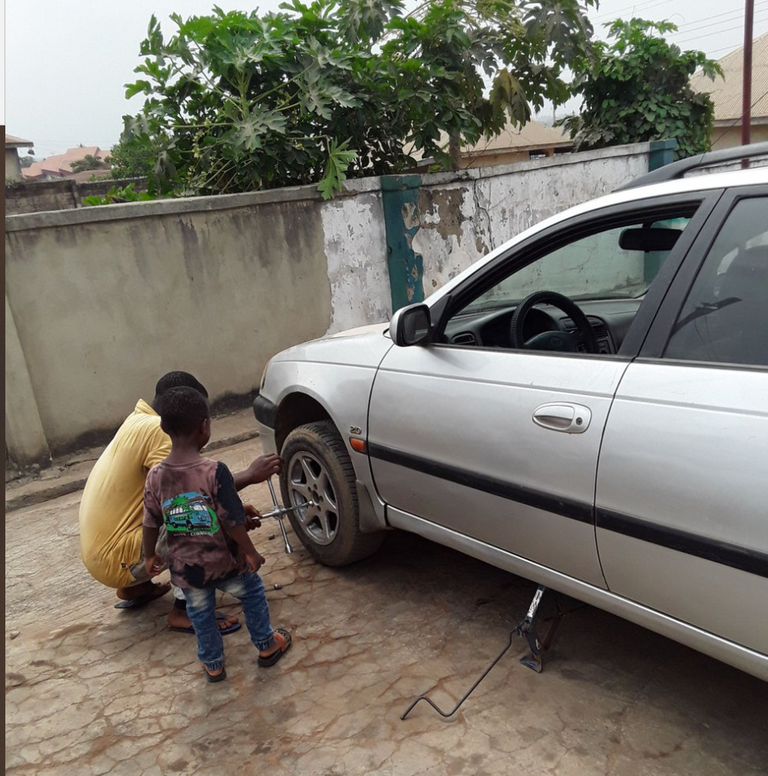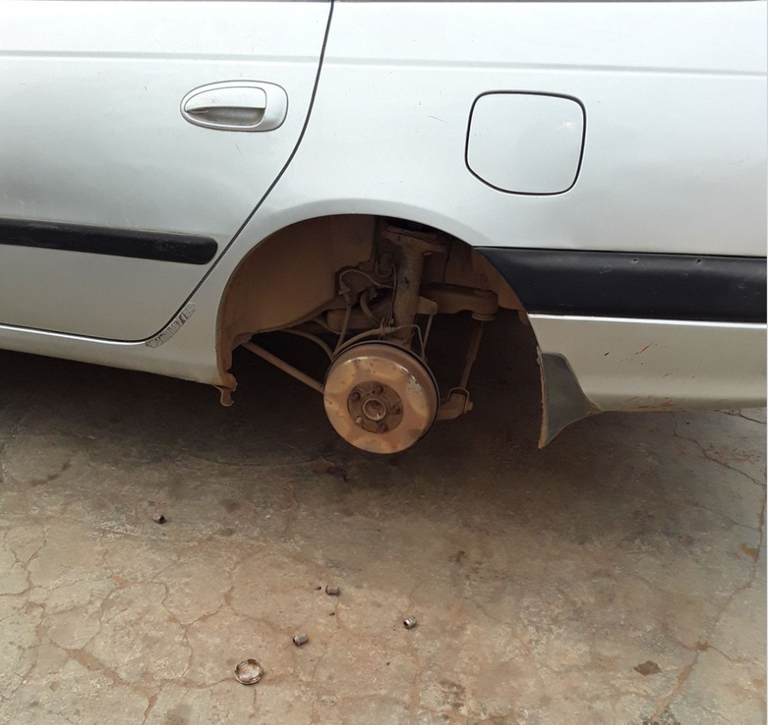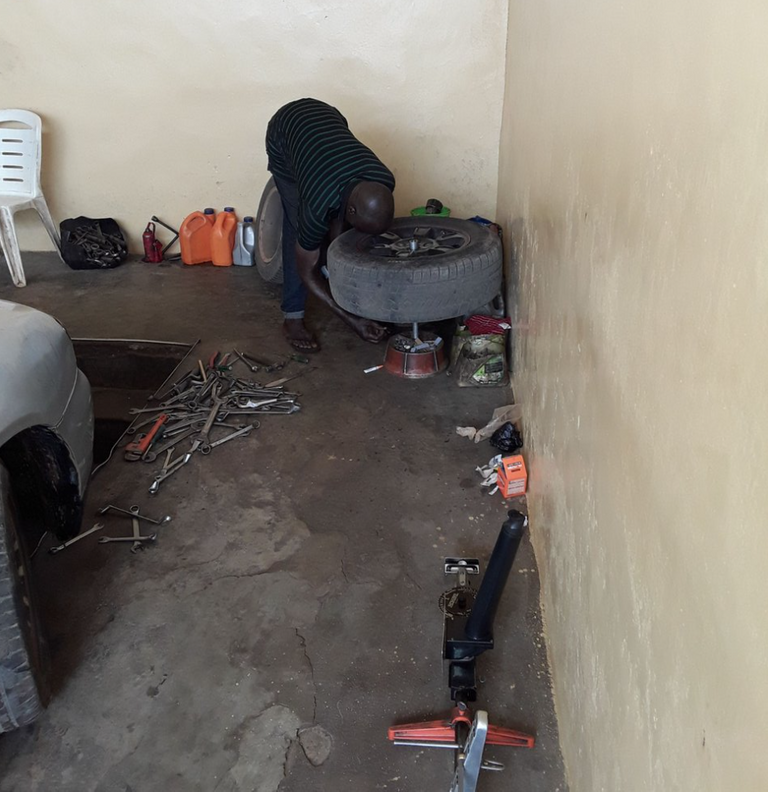Smooth Driving: A Function of Aligned and Balanced Wheels
A few weeks ago, I observed that the movement of my car was not as smooth as it used to be. From experience, I knew that at least one of the tires has likely gone bad. Perhaps it's time to change some, or even all of my tires, I thought to myself.
Knowing the economic implication of my thought, I decided to try and save up against the purchase of the tires. Maybe in about 2 months' time, the fund will be ready. Not knowing that the tires had their own plans. Just before getting to my destination that same day, the front tire on the driver's side became so wobbly that I only managed to go the few more meters needed to reach my destination - with the hazard light on.
I parked, brought out the jack and wheel spanner, jack up the car from the front tire driver side to see that the tire has has been eroded in the inner side up to the point that the binding wires are beginning to show up. In order words, the tire has been condemned beyond use. From the outside, the tire looked great. What could have happened that tires will be eroding on one side? I was convinced it is an alignment issue.

I called my mechanic just to confirm with him if my presumptive diagnosis was right. He was sure that even though the tires might need alignment, the current issue is beyond just alignment. The arms of the car need checking. Since I was not feeling so great around that period, I told him to come and take it to the workshop for checking a few days after.
He confirmed that the low arm bushings needed replacement, after which alignment for the tires was recommended. He also confirmed that, at least, two of the tires must be replaced. I sent him money to get new low-arm bushings and asked him to do the alignment before bringing it back home. He brought the car back in the evening of the same day. I regained my strength a few days after and decided to go out and get fairly used tires as new ones are quite expensive.
When is alignment necessary?
When I started driving, I learned that alignment is necessary whenever a major fault is corrected on the arms of cars. When driving on a smooth road, a car that lacks alignment issues should continue on a straight line even without holding the steering. Once a car starts pulling to the left or to the right without any hindrance to the tires, such a car requires alignment.
Beyond my initial knowledge, wheel alignment is recommended for cars that usually travel through bumpy roads or roads littered with potholes. Even when the usual roads plied by a car are smooth, wheel alignment is routinely recommended between 2 to 3 years intervals, when tires are replaced, or when a car enters into an accident.

Well-aligned tires will make for a smooth driving experience, prolongs the lives of the tires as the uneven wearing of tires is one of the symptoms of bad alignment, make the suspension system last longer, and reduce the likelihood of tire blowouts while on the road.
Basically, aligning a car has to do checking and adjusting the angles that the car's suspensions make with themselves and the body of the car itself. Three attributes of the suspension system are checked - the camber, the toe, and the caster.
When is wheel balancing necessary?
Wheel balancing refers to balancing the weight of wheels in relation to the tires. This is done using a precision machine and as pointed out in the definition, when tires are placed on wheels. In other words, wheel balancing is necessary only when the tires of a car are replaced.
The balancing is necessary because of the uneven weight distribution of the wheel. That is, the default production condition of wheels is such that some parts are thicker while others are lighter. The wheel/tire combination is placed on the precision machine, rolled, and the light side of the wheel is detected through the oscillation of the tire. A small metal that usually comes with wheels is then attached to the light side to balance the entire structure.
From experience, once the car speedometer goes above 80 km/hr and vibration sets in, I know that the wheels of the car need balancing. The speed threshold might vary from car to car, however.

Around here, wheel alignment technicians are quite common, unlike wheel balancing technicians. This could, perhaps, be due to the cost of the precision machine or the technical know-how. In my own case, I took the long trip to a technician that has knowledge of the two.
The first thing he did was to remove all the four tires and balance their weights with their wheels one after the other. Thereafter, the car was driven onto a ramp where the alignment was done. The entire process took less than 30 minutes.
Summary
Wheel alignment and balancing of cars are necessary for a smooth driving experience. In addition, aligned wheels will prolong the lives of tires and the suspension system of cars as well as reduce the probability of having tire blowout.
Thank you all for reading.
Resources
https://www.supaquick.com/blog/the-importance-of-wheel-balancing-andalignment-for-safe-driving
https://www.ceat.com/blog/car-tyres/get-to-know-your-car-how-often-should-wheel-alignments-be-done.html.
https://twitter.com/gentleshaid/status/1477572560514654212
The rewards earned on this comment will go directly to the person sharing the post on Twitter as long as they are registered with @poshtoken. Sign up at https://hiveposh.com.
Seems you know a lot about these things for a non-mechanic, do you have some mechanic history or did you learn them from reading stuffs like the one in your reference?
I've got more than 15 years driving cars. You pick up these things along way when there are faults. Driving in Nigeria, I visit the mechanic at least, once in 3 months. It won't be totally out of place to pick up some mechanic experience if one visits and watch them work at such a frequency. I also read a lot about car issues.
Cool😎👍
Goodness! I am just glad you were not driving and the tire blew out.
Yes, having an alignment and balancing is important for maintaining your tires longer. People often overlook this.
Another very simple trick is doing regular tire rotations is also very important as well and I highly recommend it.
You mean one should not stick to the same set of tires for long? Use them for some time, replace, come back to them later?
No, rotate them around to different positions.
Right front to left rear, left rear to right rear etc.
Oh, that's really awesome. WOuld definitely be trying out that
Yeah, just basically switching front tires to the opposite rear, and rear tires to opposite front. Then after a couple of thousand km, rotate them in a different direction. The intent is to try and get the tires to wear evenly.
Might stick to walking because owning a car seems so complicated.
How will I know to check these things?
Lol... I know women that have been driving for years, yet don't know all these things. As long as car keeps starting and moving, many women think it's OK.
I might be that woman 😆 I'll probably buy a car because it is pretty.
I try to have knowledge of everything but cars have never been my thing.
Here in the States, the techs usually check them for you when you've been a regular at the shop for inspections, oil change, etc.
Nothing like that around here. No one will automatically check for you unless you specifically ask. Those that do not know often learn the hard way, when the car develops major faults
Thanks for your contribution to the STEMsocial community. Feel free to join us on discord to get to know the rest of us!
Please consider delegating to the @stemsocial account (85% of the curation rewards are returned).
You may also include @stemsocial as a beneficiary of the rewards of this post to get a stronger support.
Your content has been voted as a part of Encouragement program. Keep up the good work!
Use Ecency daily to boost your growth on platform!
Support Ecency
Vote for new Proposal
Delegate HP and earn more
You were somewhat lucky nothing worse happened. Cars are just money black holes when it come to fix their parts... ;)
Money black holes indeed :). I've seen cars with pulled suspension on the road several times and I don't ever pray to be in that situation.
In my car, it is the car's computer that broke down... Such a piece of technology is so expensive :(
I can really relate with this post. I know how problematic wheel alignment and balancing issues can be, I had to stop learning how to drive with my dad's car after I almost had an accident with an oncoming vehicle as a result of the car swerving out of control. I agree with @gentleshaid when he pointed out the rarity of wheel balancing technicians especially in this part of the world. I can't count the number of times my Dad paid just to balance his car wheels, but those wheels just won't balance, turns out the wheel balancing technicians didn't know their job at all. They worked based on trial and error. The problem only got solved after he took a long trip to a competent wheel balancer with the necessary equipments after recommendation from a neighbourhood friend.
The way to learn is always like this, one should learn to do it himself to a point so it knows if others are doing it properly, like us or not, sometimes is what life give us in order to have some level of independece and be able to defend both our goods and us.